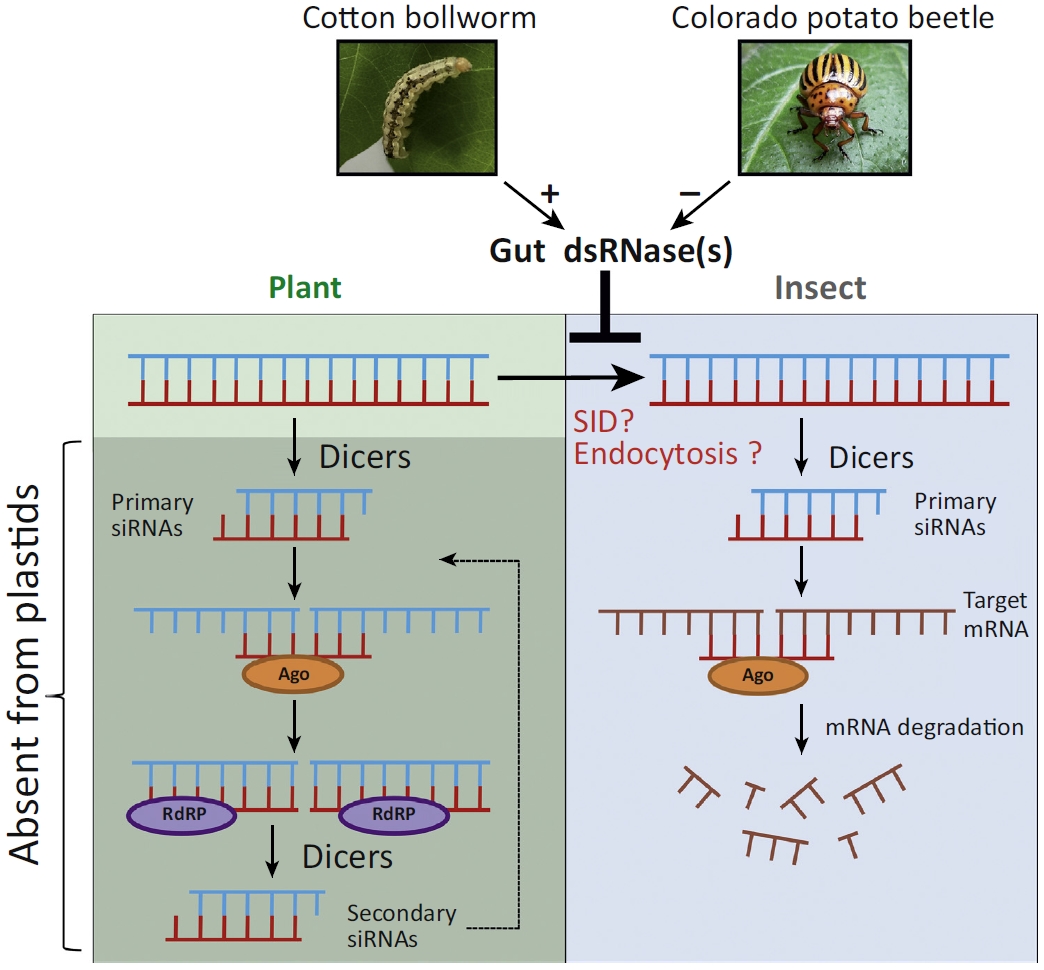在植物中表达dsRNA来达到抗虫的策略起始于陈晓亚院士的棉花中表达棉铃虫细胞色素单氧酶P450基因(CYP6AE14 )的dsRNA ,削弱幼虫对棉酚抗性【Silencing a cotton bollworm P450 monooxygenase gene by plant-mediated RNAi impairs larval tolerance of gossypol】,之后不同学者将其运用于实验中(【A transgenic strategy for controlling plant bugs (Adelphocoris suturalis) through expression of double-stranded RNA homologous to fatty acyl-coenzyme A reductase in cotton】)。
作用机制

Figure 1. An Updated Model of RNAi-Mediated Crop Protection from Insect Pests. Insecticidal dsRNAs expressed in planta either undergo processing into small interfering RNAs (siRNAs) or are imported into insect cells upon feeding on the plant, presumably by homologs of the double-stranded RNA (dsRNA) transport protein SID (originally discovered and subsequently characterized in detail in Caenorhabditis elegans [30]) and/or by endocytosis. Because insects do not possess RNA-dependent RNA polymerases (RdRPs), and therefore silencing signals cannot be amplified in insect cells, the RNAi response in the insect is largely dependent on the input of dsRNA that is taken up from the host plant. Efficient processing of dsRNAs expressed from the plant nuclear genome into siRNAs constrains the RNAi effect on the insect. This obstacle can be overcome by high-level expression of long dsRNAs in plastids (chloroplasts), a double membrane-surrounded cell organelle that lacks an RNAi machinery. Consequently, long dsRNAs produced inside the plastid are protected from cleavage by Dicer enzymes and remain stable. In this way, plastid expression of insecticidal dsRNAs provided complete protection of potato plants against the Colorado potato beetle [19]. However, dsRNase enzyme(s) present in the midgut of lepidopteran insects, such as the cotton bollworm, may degrade dsRNAs upon release from ingested leaf material and thus impede the RNAi responses.
术语
- dsRNA-specific ribonuclease(dsRNase): an enzyme, typically an endoribonuclease, that specifically degrades dsRNAs.
- RNA-dependent RNA polymerase(RdRP): an RNA polymerase capable of using single-stranded RNA as template to synthesize a complementary RNA strand. By catalyzing the replication of RNA, RdRPs can amplify silencing signals generated by dsRNAs.
- Small interfering RNA (siRNA): a class of small non-coding RNA molecules (typically 20–25 bp) that function in post-transcriptional gene silencing. siRNAs are generated from dsRNA in the RNA interference(RNAi) pathway and induce the degradation of mRNAs with complementary sequences. siRNA不仅能引导RISC切割同源单链mRNA,而且可作为引物与靶RNA结合并在RNA聚合酶(RNA-dependent RNA polymerase,RdRP)作用下合成更多新的dsRNA,新合成的dsRNA再由Dicer切割产生大量的次级siRNA(Secondary siRNAs),从而使RNAi的作用进一步放大,最终将靶mRNA完全降解。
干涉效率和面临挑战
Most of the dsRNA is processed into siRNAs in the plant, which are taken up much less efficiently by insect cells than is long dsRNA.
- The concentration of insecticidal dsRNA in the plant tissue consumed is particularly important.
- The length of the dsRNA fragment produced in the plant.
- The physiology of the insect gut or hemolymph.
- The choice of the target gene to be silenced in the insect.
参考文献
1.Luo, J. et al. A transgenic strategy for controlling plant bugs (Adelphocoris suturalis) through expression of double-stranded RNA homologous to fatty acyl-coenzyme A reductase in cotton. New Phytol 215, 1173–1185 (2017).
2.Zhang, J., Khan, S. A., Heckel, D. G. & Bock, R. Next-Generation Insect-Resistant Plants: RNAi-Mediated Crop Protection. Trends in Biotechnology 35, 871–882 (2017).
